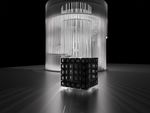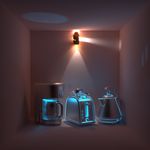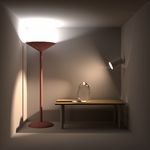Supplementary Material: Hierarchical Neural Reconstruction for Path Guiding Using Hybrid Path and Photon Samples - UCSD CSE
←
→
Page content transcription
If your browser does not render page correctly, please read the page content below
Supplementary Material:
Hierarchical Neural Reconstruction for Path Guiding Using Hybrid
Path and Photon Samples
SHILIN ZHU, University of California San Diego, USA
ZEXIANG XU, Adobe Research, USA
TIANCHENG SUN, University of California San Diego, USA
ALEXANDR KUZNETSOV, University of California San Diego, USA
MARK MEYER, Pixar Animation Studios, USA
HENRIK WANN JENSEN, University of California San Diego and Luxion, USA
HAO SU, University of California San Diego, USA
RAVI RAMAMOORTHI, University of California San Diego, USA
CCS Concepts: • Computing methodologies → Ray tracing. that are hidden behind objects with complex geometry, NEE can
ACM Reference Format: be useful in the beginning to quickly connect to one of the light
Shilin Zhu, Zexiang Xu, Tiancheng Sun, Alexandr Kuznetsov, Mark Meyer, sources. In general, NEE is more useful for a path sample based
Henrik Wann Jensen, Hao Su, and Ravi Ramamoorthi. 2021. Supplementary guiding approach (e.g., [Müller et al. 2017; Rath et al. 2020]) than
Material: Hierarchical Neural Reconstruction for Path Guiding Using Hybrid a photon-based approach (e.g., [Zhu et al. 2020]), since photons
Path and Photon Samples. ACM Trans. Graph. 40, 4, Article 35 (August 2021), already provided sufficient information about visible incident lights
4 pages. https://doi.org/10.1145/3450626.3459810 from a surface point. However, for the Bathroom scene, the glass
bulb fixture and staggered window blinds reduce the chance of
1 SUPPLEMENTARY MATERIAL successful direct NEE connection to any light source. Therefore,
In the supplementary material, we present some additional experi- most methods cannot benefit much from NEE in this special case.
mental results. These evaluations are still important when we design In general, whether NEE is contributing or not depends on the local
a full-fledged path guiding system for arbitrary scenes in practice. light visibility as well as the specific NEE technique. More advanced
direct sampling methods such as the light hierarchy [Walter et al.
1.1 Next Event Estimation (NEE) 2005] are able to sample the direct illumination more efficiently over
Similar to Müller et al. [2017] and Vorba et al. [2014], the default the standard NEE, and it is interesting to study how path guiding
setting in our main paper turns off the next event estimation (NEE) interacts with those methods in future research.
to more clearly compare the effectiveness of different path guiding In fact, although our method benefits less from NEE compared to
algorithms. However, NEE has already been a prevalent module in other baselines, we can still achieve better performance (although
modern renderers, and often it is able to ease the search of hidden or the gain is reduced), thanks to our high-quality sampling distribution
small light sources. Besides, NEE can sometimes also help in acceler- reconstruction framework which captures both direct and indirect
ating the path guiding algorithms by providing initial information illumination. In practice, it is often a good choice to request NEE,
on potential light locations. but the decision is also affected by the total timing or sampling
Therefore, we turn on the standard NEE and see how it affects budget in specific applications.
the performance of each path guiding algorithm. In Fig. 1, we test
on two scenes used in our main paper with different light setups. 1.2 Monte-Carlo (MC) Denoising
For the Racing Car scene, because there are multiple tiny lights The standard Monte-Carlo path tracing algorithm has the slow
Authors’ addresses: Shilin Zhu, University of California San Diego, USA, shz338@ convergence problem, which requires running the algorithm for a
eng.ucsd.edu; Zexiang Xu, Adobe Research, USA, zexu@adobe.com; Tiancheng Sun, long time to produce noise-free images [Kajiya 1986; Lafortune 1996].
University of California San Diego, USA, tis037@eng.ucsd.edu; Alexandr Kuznetsov, In the past few years, MC denoising has been researched to reduce
University of California San Diego, USA, a1kuznet@eng.ucsd.edu; Mark Meyer, Pixar
Animation Studios, USA, mmeyer@pixar.com; Henrik Wann Jensen, University of the last-mile residual pixel variance by filtering over the rendered
California San Diego and Luxion, USA, henrik@cs.ucsd.edu; Hao Su, University of image. Among all of these proposed methods, deep learning based
California San Diego, USA, haosu@eng.ucsd.edu; Ravi Ramamoorthi, University of
California San Diego, USA, ravir@cs.ucsd.edu.
denoising for path tracing results using a CNN has become a very
successful approach [Bako et al. 2017; Chaitanya et al. 2017; Vogels
Permission to make digital or hard copies of part or all of this work for personal or et al. 2018]. This greatly increases the visual quality of the image
classroom use is granted without fee provided that copies are not made or distributed
for profit or commercial advantage and that copies bear this notice and the full citation with a small risk of bias introduced to the results.
on the first page. Copyrights for third-party components of this work must be honored. A practical and straightforward way to combine path guiding with
For all other uses, contact the owner/author(s). denoising is to apply the neural denoiser on path guiding results.
© 2021 Copyright held by the owner/author(s).
0730-0301/2021/8-ART35 More specifically, we use the built-in neural denoiser from Nvidia
https://doi.org/10.1145/3450626.3459810 OptiX 6.5 [Parker et al. 2010], which runs on the GPU, on all the
ACM Trans. Graph., Vol. 40, No. 4, Article 35. Publication date: August 2021.35:2 • Shilin Zhu, Zexiang Xu, Tiancheng Sun, Alexandr Kuznetsov, Mark Meyer, Henrik Wann Jensen, Hao Su, and Ravi Ramamoorthi
Path Müller Rath et al. Zhu et al. Path Müller Rath et al. Zhu et al.
Ours Ours
Tracer [2019] [2020] [2020] Tracer [2019] [2020] [2020]
NEE off
0.5534 0.0814 0.0726 0.0172 0.0079 0.6891 0.0397 0.0312 0.0179 0.0091
NEE on
0.0097 0.0160 0.0158 0.0056 0.0037 0.0706 0.0250 0.0162 0.0104 0.0078
Racing Car rMSE (NEE off) 0.7141 0.1244 0.1193 0.0249 0.0160
rMSE(NEE on) 0.1579 0.0487 0.0431 0.0125 0.0082
NEE off
0.0600 0.0377 0.0115 0.0098 0.0041 0.1381 0.0620 0.0214 0.0137 0.0076
NEE on
0.0596 0.0329 0.0110 0.0092 0.0040 0.1350 0.0579 0.0196 0.0117 0.0070
Bathroom rMSE (NEE off) 0.0709 0.0265 0.0098 0.0062 0.0033
rMSE(NEE on) 0.0705 0.0240 0.0092 0.0056 0.0032
Fig. 1. The effect of the standard next event estimation (NEE) on the results rendered equal-time for each row. NEE can improve the results in some scenes
when it is hard for path tracing to find lights in the beginning. However, it is not very efficient in some other light transport scenarios when most direct
connections fail.
Path Müller Rath et al. Zhu et al. Path Müller Rath et al. Zhu et al.
Ours Ours
Tracer [2019] [2020] [2020] Tracer [2019] [2020] [2020]
Denoise off
0.3077 0.0495 0.0412 0.0203 0.0085 0.2432 0.0323 0.0207 0.0137 0.0084
Denoise on
0.0365 0.0219 0.0252 0.0137 0.0126 0.0159 0.0057 0.0053 0.0043 0.0026
Caustics Egg rMSE 0.2968 0.0139 0.0111 0.0045 0.0023
rMSE(denoised) 0.0138 0.0034 0.0040 0.0008 0.0006
Denoise off
0.9088 0.6488 0.6912 0.2654 0.0957 0.9932 0.5852 0.5804 0.3688 0.0940
Denoise on
0.2379 0.2057 0.2054 0.0711 0.0298 0.2015 0.2371 0.1318 0.0606 0.0208
Light Maze rMSE 0.9031 0.4833 0.4973 0.1636 0.0867
rMSE(denoised) 0.2213 0.1434 0.1196 0.0424 0.0138
Fig. 2. The effect of Monte-Carlo denoising on path guiding results. The neural network based MC denoiser in Nvidia OptiX 6.5 is used here to process all the
images. The denoiser fills the black pixels and smooths out the high-frequency noise. Thanks to our high-quality reconstructed sampling distributions, our
initial rendered results contain less noise and are more acceptable after denoising without severe blur or distortion.
result images from our method and baselines. Results in Fig. 2 show had only a small amount of high-frequency noise, otherwise the
that denoising can effectively smooth the results and remove most denoised image can be distorted or over-blurry (e.g., the wall in the
of the high-frequency artifacts. Moreover, our method still achieves Caustics Egg scene and the cube in the Light Maze scene).
better visual quality even after MC denoising. This is because the
denoising performs best when the original rendered image already 1.3 Additional Ablation Results
ACM Trans. Graph., Vol. 40, No. 4, Article 35. Publication date: August 2021.Supplementary Material:
Hierarchical Neural Reconstruction for Path Guiding Using Hybrid Path and Photon Samples • 35:3
Iteration 0 Iteration 2 Iteration 4 Iteration 6 Iteration 8 Iteration 10 Reference
Fig. 3. Visualization of the reconstructed quadtree over iterations. In general, our reconstruction is more conservative in the beginning thus the quadtree is
shallower. After more samples are collected over time, our reconstructed quadtree becomes more accurate and fine-grained, which eventually can converge to
the target sampling distribution.
Racing Car Kitchen Ours-PathOnly Ours Reference
0.0253 0.0131
Racing Car 0.0119 0.0057
Fig. 5. The effectiveness of using hybrid samples (path samples and photons).
Because of the complex visibility of the light sources, using photons is more
beneficial than path samples in this scene. The presented insets clearly show
the advantage of our hybrid sample framework.
Fig. 4. The effectiveness of sample features introduced in the main paper.
We show two curves with and without including the auxiliary features as
the neural network input, and results show a slight improvement when
features are considered. converges to the reference distribution. It also shows that our neural
path guiding framework can process inputs of different noise and
sparsity levels.
We also try experimenting with more different setups in our pro-
posed framework. To justify the use of the sample features as il- 1.5 FLIP Metric
lustrated in the main paper, we have trained another version of In the main paper, we use rMSE as our primary metric to quan-
the network that only takes the sample value (i.e., irradiance of titatively measure the quality of the rendering results. Here, we
path samples, or power of photons) as the input. Results in Fig. 4 use a recently proposed metric called FLIP [Andersson et al. 2020]
show that features can offer some improvements to the final ren- which can closely reflect the human perception of image differences.
dered image by enabling higher-quality reconstructed sampling In addition, FLIP can also output a map that illustrates the error
distributions. distribution over the scene. In Fig. 6, we show that our method can
Since our approach takes both path samples and photons as input, produce results that have overall less noise within the entire image.
it is also necessary to study how this decision affects the perfor-
mance and robustness. In the main paper, we have verified the REFERENCES
increased robustness in the extreme light transport conditions. To Pontus Andersson, Jim Nilsson, Tomas Akenine-Möller, Magnus Oskarsson, Kalle
further justify the necessity of hybrid samples, we train another Åström, and Mark D Fairchild. 2020. FLIP: a difference evaluator for alternating
network with only path sample input (i.e., without photons). The images. Proceedings of the ACM on Computer Graphics and Interactive Techniques
(HPG 2020) 3, 2 (2020).
comparison to our full model is shown in Fig. 5. Although "Ours- Steve Bako, Thijs Vogels, Brian McWilliams, Mark Meyer, Jan Novák, Alex Harvill,
PathOnly" is also powered by a similar neural network, removing Pradeep Sen, Tony Derose, and Fabrice Rousselle. 2017. Kernel-predicting convo-
one type of samples from the framework can possibly cause perfor- lutional networks for denoising Monte Carlo renderings. ACM Trans. Graph. 36, 4
(2017), 97–1.
mance to downgrade, especially when the one being neglected is Chakravarty R Alla Chaitanya, Anton S Kaplanyan, Christoph Schied, Marco Salvi,
more useful than the one being used. Aaron Lefohn, Derek Nowrouzezahrai, and Timo Aila. 2017. Interactive reconstruc-
tion of Monte Carlo image sequences using a recurrent denoising autoencoder. ACM
Transactions on Graphics (TOG) 36, 4 (2017), 1–12.
1.4 Visualization of Quadtrees James T Kajiya. 1986. The rendering equation. In Proceedings of the 13th annual
conference on Computer graphics and interactive techniques. 143–150.
In the main paper, we visualize and compare the sampling distri- Eric Lafortune. 1996. Mathematical models and Monte Carlo algorithms for physically
bution representations of different methods. In Fig. 3, we further based rendering. Department of Computer Science, Faculty of Engineering, Katholieke
demonstrate how our reconstructed quadtree gets updated and Universiteit Leuven 20 (1996), 74–79.
Thomas Müller, Markus Gross, and Jan Novák. 2017. Practical path guiding for efficient
evolved over multiple iterations. We can see the sampling distribu- light-transport simulation. In Computer Graphics Forum, Vol. 36. Wiley Online
tion becomes more accurate and detailed with time, which gradually Library, 91–100.
ACM Trans. Graph., Vol. 40, No. 4, Article 35. Publication date: August 2021.35:4 • Shilin Zhu, Zexiang Xu, Tiancheng Sun, Alexandr Kuznetsov, Mark Meyer, Henrik Wann Jensen, Hao Su, and Ravi Ramamoorthi Fig. 6. FLIP error maps on example scenes from the main paper (brighter color means larger error). The number below each image represents the average error of all the pixels. Steven G Parker, James Bigler, Andreas Dietrich, Heiko Friedrich, Jared Hoberock, asymmetric loss functions. ACM Transactions on Graphics (TOG) 37, 4 (2018), 1–15. David Luebke, David McAllister, Morgan McGuire, Keith Morley, Austin Robison, Jiří Vorba, Ondřej Karlík, Martin Šik, Tobias Ritschel, and Jaroslav Křivánek. 2014. et al. 2010. OptiX: a general purpose ray tracing engine. Acm transactions on graphics On-line learning of parametric mixture models for light transport simulation. ACM (tog) 29, 4 (2010), 1–13. Transactions on Graphics (TOG) 33, 4 (2014), 1–11. Alexander Rath, Pascal Grittmann, Sebastian Herholz, Petr Vévoda, Philipp Slusallek, Bruce Walter, Sebastian Fernandez, Adam Arbree, Kavita Bala, Michael Donikian, and and Jaroslav Křivánek. 2020. Variance-Aware Path Guiding. ACM Transactions on Donald P Greenberg. 2005. Lightcuts: a scalable approach to illumination. In ACM Graphics (Proceedings of SIGGRAPH 2020) 39, 4 (July 2020), 151:1–151:12. https: SIGGRAPH 2005 Papers. 1098–1107. //doi.org/10.1145/3386569.3392441 Shilin Zhu, Zexiang Xu, Tiancheng Sun, Alexandr Kuznetsov, Mark Meyer, Henrik Wann Thijs Vogels, Fabrice Rousselle, Brian McWilliams, Gerhard Röthlin, Alex Harvill, David Jensen, Hao Su, and Ravi Ramamoorthi. 2020. Photon-Driven Neural Path Guiding. Adler, Mark Meyer, and Jan Novák. 2018. Denoising with kernel prediction and arXiv preprint arXiv:2010.01775 (2020). ACM Trans. Graph., Vol. 40, No. 4, Article 35. Publication date: August 2021.
You can also read
























































